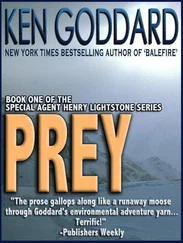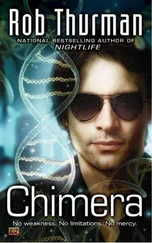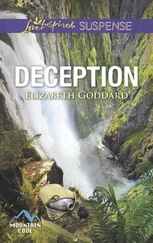Ken Goddard - Chimera
Здесь есть возможность читать онлайн «Ken Goddard - Chimera» весь текст электронной книги совершенно бесплатно (целиком полную версию без сокращений). В некоторых случаях можно слушать аудио, скачать через торрент в формате fb2 и присутствует краткое содержание. Жанр: Триллер, на английском языке. Описание произведения, (предисловие) а так же отзывы посетителей доступны на портале библиотеки ЛибКат.
- Название:Chimera
- Автор:
- Жанр:
- Год:неизвестен
- ISBN:нет данных
- Рейтинг книги:5 / 5. Голосов: 1
-
Избранное:Добавить в избранное
- Отзывы:
-
Ваша оценка:
- 100
- 1
- 2
- 3
- 4
- 5
Chimera: краткое содержание, описание и аннотация
Предлагаем к чтению аннотацию, описание, краткое содержание или предисловие (зависит от того, что написал сам автор книги «Chimera»). Если вы не нашли необходимую информацию о книге — напишите в комментариях, мы постараемся отыскать её.
Chimera — читать онлайн бесплатно полную книгу (весь текст) целиком
Ниже представлен текст книги, разбитый по страницам. Система сохранения места последней прочитанной страницы, позволяет с удобством читать онлайн бесплатно книгу «Chimera», без необходимости каждый раз заново искать на чём Вы остановились. Поставьте закладку, и сможете в любой момент перейти на страницу, на которой закончили чтение.
Интервал:
Закладка:
Then, after walking around to the side of the glove box and opening the outside door of the vacuum chamber, the three forensic scientists came back to the workbench, the vial in Ferreira’s hand and the evidence box in Hager’s.
“Can we watch what you’re doing, or should we be running for the door?” Bulatt asked.
“Sure, come on over, no problem,” Ferreira said as she sat back down at the workbench and began making adjustments to a low-power dissection microscope. Renwick and Hager took chairs on either side of the microscope station.
“Was all that glove-box business really necessary?” Bulatt asked as he and Achara cautiously approached the workbench.
“Probably not,” Ferreira said as she opened the vial, removed the now-soggy white tissue clump with a pair of plastic forceps, set it into a small glass Petri dish, placed the dish under the dissection microscope, and began to tease apart the wet tissue. “The nano-probes we found in those Clouded Leopard carcasses broke down real quick under UV light, once we isolated them from the lymphatic system, so exposure to air and sunlight at the Preserve in Thailand should have sterilized the bullet and the cartridge case. But there may be some completely isolated tissue under that peeled-back jacketing, and we’re still trying to figure out what the DNA segments attached to the nano-tubes do, so we don’t want to take any chances.”
“Appreciate that,” Bulatt muttered, eyeing the now-exposed mushroomed rifle bullet that Ferreira was slowly moving into the view-field of the microscope with a whole new appreciation for its lethal nature.
“That’s also why we asked you and the Chief to take a good soapy shower and go though that decontamination procedure with the evidence box,” Ferreira explained to Achara as she carefully turned the pullet onto its mushroomed tip, “just in case.”
“Finding anything?” Renwick asked.
“Um, yeah, definitely picked up some animal hairs — looks like grey, white and light brown — and a bunch of tissue, all tucked up nice and safe under the peeled-back jacketing.” Mumbling to herself now, Ferreira began using the plastic forceps and another plastic probe to carefully remove hairs and bits of bloody tissue from under the mushroomed bullet tip, placing the recovered hairs in a small sterile capped vial and the tissue bits into a second identical vial.
After another thirty seconds, Ferreira got up, said, “I’ve got my samples,” and walked purposefully out the door of the Criminalistics lab; on her way to the Genetics lab with her vials and notes.
“My turn,” Renwick said as he moved into the chair vacated by Ferreira, and put his eyes up against the eyepieces of the dissecting microscope. “Let’s see what we’ve got here.”
As Renwick carefully manipulated the bullet under the microscope with the same plastic forceps, Hager gently slid a folded ‘C-shaped’ two-inch-wide strip of cardboard out of the small evidence box. The top and bottom ‘C’ ends of the cardboard strip were pressed against the base and mouth of a fired brass rifle cartridge casing — the casing being held in place by a twig stuck through the top end of the cardboard and into the cartridge mouth — the entire structure being held tightly together with a looping wrap of duct tape. The effect was a protective three-sided cardboard shield protecting the secured casing from any outside source of abrasion.
“Looks like a point-two-four-three casing,” Hager said. “I’ll check the base for confirmation after I finish the latent work.”
“Based on the scope reticule, the bullet appears to be a two-four-three also,” Renwick said, talking mostly to Hager who was now examining the casing under a low-powered magnifying lens. “I’ll confirm with the calipers after I make the scan.” He reached over with one hand to take another series of photos with the digital camera built into the microscope, and then made a few notations to his exam form.
“The twig’s a nice touch,” Hager said as he continued to examine the surface of the protected casing with an angled flashlight beam. “You teach him that?” he asked, looking back up at Bulatt.
“All I did was explain the basic principles of preserving evidence; he took it from there,” Bulatt said. “From what I could see, the Chief’s a natural crime scene investigator.”
“Yes, Chief Narusan is very enthusiastic, and very happy with his new assignment,” Achara added.
“Well, keep encouraging him; he does a lot better job of collecting and preserving evidence than most of our agents,” Hager said as he placed the ‘’C’ structure back on the workbench, took a series of quick digital photographs from different angles, and then began to make more notations on his evidence exam form.
“I’m going to start a NIBIN scan on the bullet,” Renwick said as he stood up with the gauze-wrapped bullet in one hand and his notes in the other.
“Sounds good,” Hager acknowledged as Renwick headed toward the door. “I’ll get the casing over to you in about a half hour or so, as soon as I finish the processing.”
Then Hager looked up at Bulatt and Achara. “This is the exciting part for us latent-print jockeys; you two like to watch?”
Latent Print Lab, National Fish amp; Wildlife Forensics Lab
In the latent print lab, Bulatt and Achara adjusted pairs of orange-tinted goggles over their eyes, and then watched as Hager first carefully fumed the cartridge casing that was now mounted inside a glass-faced fume hood, and then adjusted the beam of an adjustable-frequency light source until the brass surface began to glow.
“Oh yes,” Hager finally laughed in cheerful satisfaction as he stepped back from the front of the fume hood, allowing Bulatt and Achara a clear view of his work.
“Is that really a fingerprint?” she asked in a disbelieving whisper.
“No, my dear, that is what us forensic types call a perfect partial thumbprint,” Hager corrected.
As if responding to Hager’s words as much as the dial under his fingers, the orange-yellow thumbprint glowed even brighter, each whorl and ridge ending clearly visible to the naked — albeit goggle-aided and protected — eye.
“My god, a perfect print, how is that possible after all those hours in the sun and rain?” Achara whispered, still visibly enthralled by the glowing evidence.
“Very simple,” Hager said. “Every time you load a cartridge into a rifle magazine or chamber, you apply a perfectly identifiable latent fingerprint to the oily surface of that cartridge, which does not get obliterated when the cartridge is fired or ejected or lays around in a rainforest for several days, as this one apparently did. So, if the scene investigator knows what he or she is doing, and collects the casing properly — and gets it to the lab without rubbing it against any other casings or objects — we can usually visualize that print and make a database search.”
“And you’re going to be able to do that with this fingerprint; run a database search?” Achara asked, wanting confirmation.”
“Not a problem; we rarely get a print this nice to work with,” Hager confirmed.
“How long will it take to get results back?” Bulatt asked.
“On a print that distinct? Once I get the print scanned and coded, anywhere from five minutes to an hour, if we’re lucky.”
“And if not?”
Several hours, maybe several days,” Hager replied. “Depends on a lot of factors we don’t control. I could give it a higher priority, but you said you wanted to stay low-profile on our data runs.”
“Low profile is better,” Bulatt said, and then looked over at Achara. “Why don’t we go have dinner, check into a hotel, get some sleep, and let these guys do their work.”
Читать дальшеИнтервал:
Закладка:
Похожие книги на «Chimera»
Представляем Вашему вниманию похожие книги на «Chimera» списком для выбора. Мы отобрали схожую по названию и смыслу литературу в надежде предоставить читателям больше вариантов отыскать новые, интересные, ещё непрочитанные произведения.
Обсуждение, отзывы о книге «Chimera» и просто собственные мнения читателей. Оставьте ваши комментарии, напишите, что Вы думаете о произведении, его смысле или главных героях. Укажите что конкретно понравилось, а что нет, и почему Вы так считаете.












